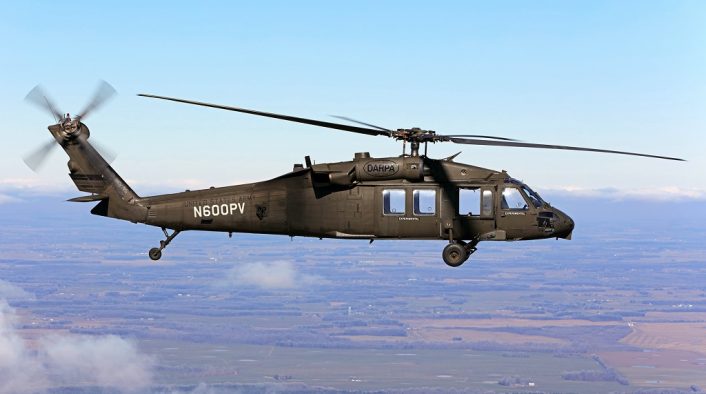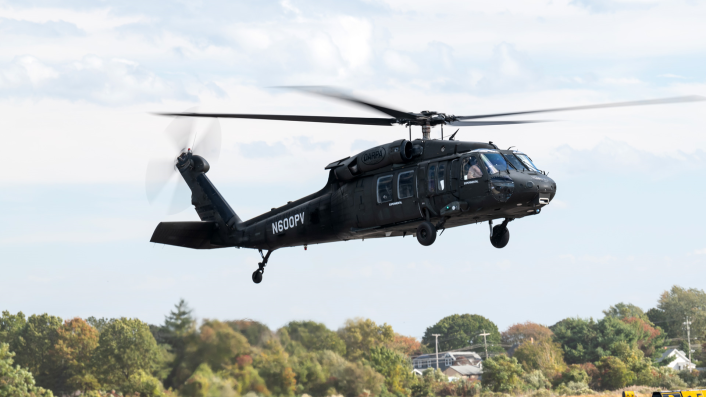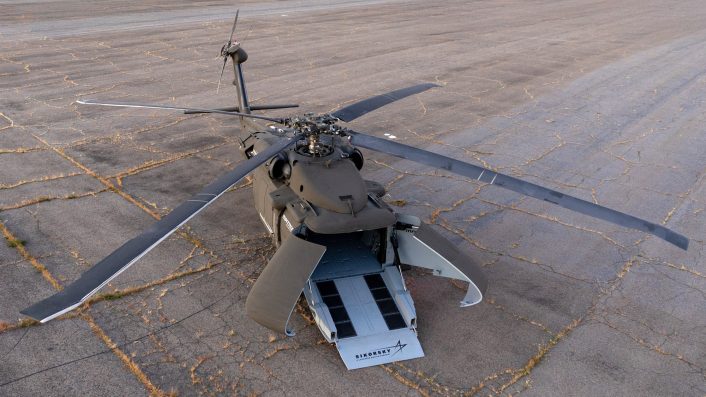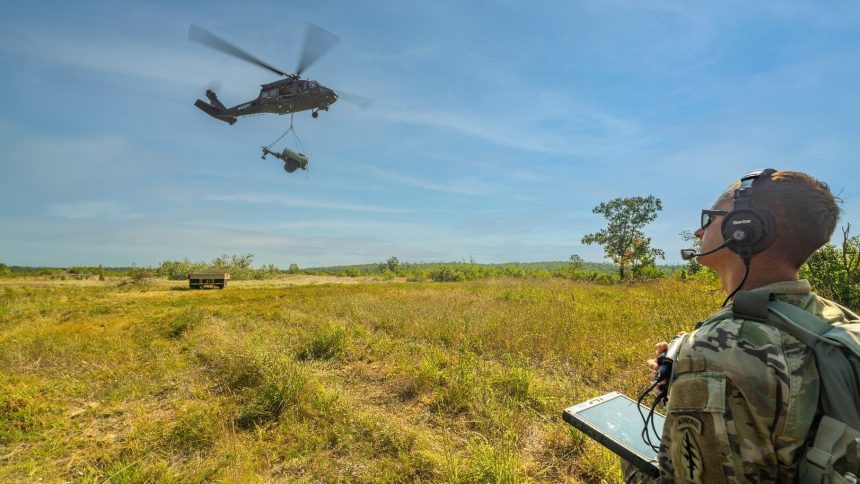A U.S. soldier was put in charge of planning and executing missions with the Optionally Piloted Black Hawk helicopter instead of a trained aviator.
Sikorsky has announced a new demonstration of the capabilities of its Optionally Piloted (OPV) Black Hawk helicopter, powered by the MATRIX technology, and what it could bring to the battlefield. During the recent Northern Strike 25-2 exercise, held in Michigan in August 2025, a U.S. Army National Guard soldier was put in charge of the planning and execution of missions with the OPV Black Hawk instead of a trained aviator or engineer.
The demonstration
Sikorsky explained the scenario created in partnership with the Joint Personnel Recovery Agency and the Defense Advanced Research Projects Association (DARPA), and had the goal of demonstrating, in an operational environment, how an autonomous Black Hawk can expand mission reach and reduce risk to soldiers.
The company said that a Sergeant First Class was trained in less than an hour on how to operate the system, before he became the first soldier to independently plan, command and execute OPV Black Hawk missions using the system’s handheld tablet. Specifically, as part of the exercise, he directed the payload to a location 70 nautical miles away and commanded multiple precision airborne drops.
Sikorsky further highlighted how this was the first time OPV Black Hawk operated fully under the control of an actual warfighter, instead of a trained test pilot or engineer. In fact, this allowed to demonstrate the maturity and ease of operation of the autonomous helicopter, without the need for lengthy specialized training.

Something similar was already demonstrated with the same helicopter and tablet, albeit in a smaller scale, when Lockheed Martin Rotary and Mission Systems President Stephanie Hill controlled the OPV Black Hawk at the AUSA (Association of the United States Army) symposium in Washington D.C. on Oct. 17, 2024. On that occasion, the tablet connected via a data link to the helicopter 300 miles (483 km) away in Bridgeport, Connecticut.
The August exercise scenario, on the other hand, saw the helicopter demonstrating three types of cargo delivery, including internal carry, external sling load and precision parachute drop, as well as a medevac exercise. It is unclear if safety pilots were present inside the cockpit, however it appears that soldiers were also onboard.
Here is an excerpt from Sikorsky’s press release detailing the operations of the helicopter during Northern Strike 25-2:
Exercise 1: Parachute Drops and Logistics Recovery
From a Coast Guard boat on Lake Huron, a soldier planned and executed a Class 1 resupply mission from 70 nautical miles away. After the cargo was unloaded, he used the tablet interface to direct the OPV Black Hawk in racetrack patterns over the lake while soldiers onboard completed two precision parachute drops at different altitudes. It was the first time the OPV Black Hawk performed precision logistics and airborne drops entirely under soldier control.
Exercise 2: Water Buffalo External Sling Load
OPV Black Hawk completed its first-ever autonomous hookup of an external load while airborne. Using its hover stability capabilities, the aircraft held position while soldiers quickly and efficiently attached a 2,900-pound water tank without pilot intervention. The demonstration showed that a MATRIX-equipped aircraft can perform complex aerial resupply missions in the field.
Exercise 3: HIMARS External Sling Load and MEDEVAC Recovery
OPV Black Hawk completed six autonomous hovering hookups to transport HIMARS launch tubes to an alternate landing zone. A soldier then used OPV Black Hawk to conduct a simulated personnel recovery, including a tail-to-tail patient transfer to a piloted Black Hawk at an unimproved landing site. This was the first time an untrained soldier commanded an autonomous MEDEVAC recovery from inside the OPV Black Hawk aircraft.
OPV Black Hawk
Five years ago, a UH-60A helicopter has been retrofitted in an Optionally Piloted Vehicle (OPV) configuration as part of the Aircrew Labor In-Cockpit Automation System (ALIAS) program. In 2022, the helicopter conducted flights without anyone onboard over the U.S. Army installation at Fort Campbell, Kentucky.
The ALIAS program aims to address challenges in military aviation by reducing pilot workload and enhancing mission performance through advanced automation. The MATRIX autonomy system forms the technological foundation for ALIAS, combined with enhanced flight controls to enable fully autonomous operations from takeoff to landing, as well as managing emergency situations.

“With lives on the line, Sikorsky’s MATRIX flight autonomy system can transform how military operators perform their missions,” said Rich Benton, vice president and general manager of Sikorsky, a Lockheed Martin company. “An optionally piloted Black Hawk aircraft can reduce pilot workload in a challenging environment or complete a resupply mission without humans on board. In contested logistics situations, a Black Hawk operating as a large drone offers commanders greater resilience and flexibility to get resources to the point of need.”
Such a system would allow to safely execute complex missions in contested environments as the autonomous flight capabilities would allow pilots to shift focus from piloting-related technical tasks to strategic mission management. The system has been thoroughly tested and has demonstrated the ability to navigate complex environments and execute missions with minimal human intervention.
S-70UAS U-Hawk
The announcement of the successful test comes few weeks after Sikorsky announced the new prototype of an unmanned Black Hawk, dubbed S-70UAS U-Hawk, during this year’s edition of AUSA. This new step toward a fully autonomous utility helicopter builds on the years of experimentation with the MATRIX autonomy suite and the optionally piloted Black Hawk
The system uses a third-generation, low-cost fly-by-wire architecture integrated with MATRIX autonomy technology to enable uncrewed flight. Similarly to the OPV Black Hawk, the U-Hawk is designed to be operated from a tablet interface that manages all phases of flight, from start-up to shutdown.

The U-Hawk replaces the Black Hawk’s cockpit with actuated clamshell doors and a forward loading ramp, resulting in 25 percent more cargo space than a conventional UH-60L. In the configuration shown in official photos, the clamshell “nose” opens upward and outward, exposing a flat cargo bay where vehicles or supplies can be loaded directly from the front.
The ramp can be lowered for drive-on operations or sealed for flight, giving the aircraft a clean, aerodynamic profile with no cockpit glazing. This redesign eliminates the traditional two-seat crew station and turns the front fuselage into an integral part of the cargo area.
By eliminating the cockpit and crew stations, the U-Hawk gains additional internal volume and flexibility for a variety of mission types. The aircraft can now accommodate oversized cargo up to its maximum gross weight, self-deploy over 1,600 nautical miles, or loiter for up to 14 hours without refueling.









